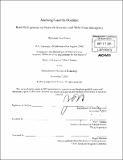| dc.contributor.advisor | Fotini Christia. | en_US |
| dc.contributor.author | Adams, Joseph Ovid | en_US |
| dc.contributor.other | Massachusetts Institute of Technology. Dept. of Political Science. | en_US |
| dc.date.accessioned | 2012-01-30T17:04:57Z | |
| dc.date.available | 2012-01-30T17:04:57Z | |
| dc.date.copyright | 2011 | en_US |
| dc.date.issued | 2011 | en_US |
| dc.identifier.uri | http://hdl.handle.net/1721.1/68943 | |
| dc.description | Thesis (S.M.)--Massachusetts Institute of Technology, Dept. of Political Science, 2011. | en_US |
| dc.description | Cataloged from PDF version of thesis. | en_US |
| dc.description | Includes bibliographical references. | en_US |
| dc.description.abstract | This thesis will assess influential guerrilla doctrine advising optimal insurgent (1) operational environment, (2) organizational structure, (3) logistical capacity, and (4) dependent tactics - items of consistent, yet incomplete analysis in counter-insurgency (COIN) analytics and civil war scholarship. Following a review of five of the most infamously disseminated guerrilla doctrine and training manuals, this thesis derives a model of advised guerrilla war production. The derived model illustrating the strategic and operational principles of reviewed doctrine presents an organizational hybrid between guerrilla hierarchies and networks, positing optimal organizational structure as a function of operational environment. Logistical capacity, tactics, target set, and military classification are in turn best determined by organizational structure. An otherwise unobserved operational dynamic relating each of the above four enumerated strategic considerations is thereby illustrated, with implications for COIN theory and praxis. To present a more systematic evaluation of reviewed guerrilla doctrine, the derived model is evaluated against a qualitative case-study of Peru's Shining Path insurgency. Case-study empirics are drawn from the Uppsala/PRIO Armed Conflicts Dataset (ACD) on dyadic conflict (Cederman, Min, Wimmer 2010), Arc Geographic Information Systems (GIS) spatial analysis software, declassified Peruvian intelligence reports, and captured Shining Path documents and directives from the Peruvian insurrection between 1969 - 1989. This study finds that evaluated guerrilla doctrine accurately reflects the material conditions of insurgency. There is one caveat: The global trends of increasing urbanization, dissolution of state power, and decline in politically motivated insurgency, may contribute to an observed shift in non-state actor war production from rural to increasingly urban and civilian-centric economies of violence. Lessons on strategically important considerations like sanctuary, terrain, state capacity, network evolution, and weapons proliferation, attend. | en_US |
| dc.description.statementofresponsibility | by Joseph Ovid Adams. | en_US |
| dc.format.extent | p. | en_US |
| dc.language.iso | eng | en_US |
| dc.publisher | Massachusetts Institute of Technology | en_US |
| dc.rights | M.I.T. theses are protected by
copyright. They may be viewed from this source for any purpose, but
reproduction or distribution in any format is prohibited without written
permission. See provided URL for inquiries about permission. | en_US |
| dc.rights.uri | http://dspace.mit.edu/handle/1721.1/7582 | en_US |
| dc.subject | Political Science. | en_US |
| dc.title | Assessing guerrilla doctrine: battlefield lessons on network structure and multi-front insurgency | en_US |
| dc.title.alternative | Battlefield lessons on network structure and multi-front insurgency | en_US |
| dc.type | Thesis | en_US |
| dc.description.degree | S.M. | en_US |
| dc.contributor.department | Massachusetts Institute of Technology. Department of Political Science | |
| dc.identifier.oclc | 773757362 | en_US |
